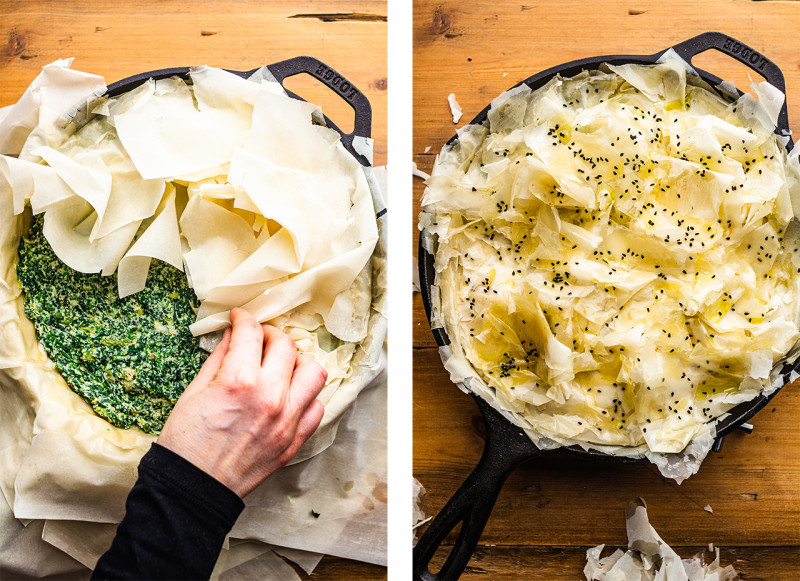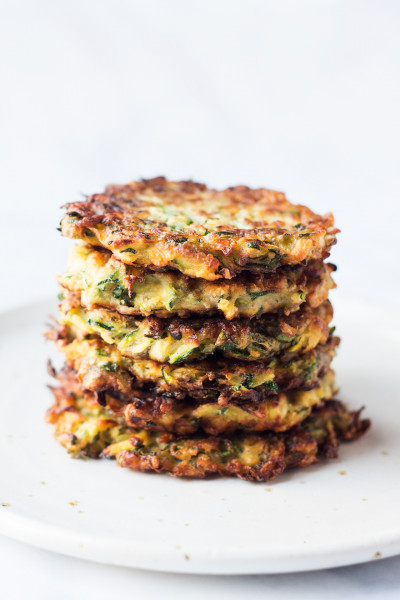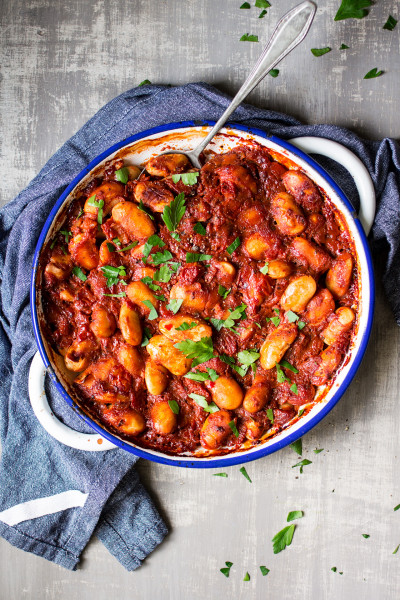
Easter is coming and Easter always takes me back to our time living in Greece hence my today’s recipe is a traditional Greek dish made without eggs or dairy – vegan spanakopita skillet. Paros – the island we lived on – was at its best just before Easter. It’s the time of the year when it’s warm and sunny, cold winter winds abate at last and hills are covered in Spring flowers and the island wakes up from winter slumber and becomes a little busier but not oppressively so.
While Greeks celebrate Easter with a spit roast and that’s actually quite hard to watch as a vegan, seven weeks preceding Easter is when a lot of religious people eat mostly vegan food and that comes quite handy when they ask you what it means that you are vegan. You simply say you eat like they do during Sarakosti – 40 days before Ash Wednesday – meaning you abstain from eating meat, dairy or fish. The only difference is that they continue to eat some seafood (like taramasalata) during this time and you obviously don’t eat that either. It’s not a perfect analogy but it’s helpful and you become less of an unknown entity when you transpose what you do to their ways of life.
Although spanakopita isn’t traditionally vegan, it’s one of these things that is easy to veganise and if you do it well, vegan version can easily rival the original. Traditional spanakopita filling is made with prolific amount of spinach (or horta – wild greens), herbs and feta cheese and it’s baked inside layers of crispy phyllo pastry. Sometimes eggs are also used to set the filling, but not very often. My vegan spanakopita uses the very same ingredients apart from the cheese, which I replace cashews (or sunflower seeds if you have a nut allergy) blended with seasonings until velvety and creamy. It works so well, I tell you.
In terms of pastry, you can of course make your own if you are an ambitious and accomplished cook with lots of time on your hands, but you really do not need to. Most commercially available phyllo pastry is made with vegetable oils instead of butter as a cost saving measure anyway so unless a brand markets itself as butter phyllo, you are unlikely to find any butter it in although check the ingredients just to be sure.
I have a couple vegan spanakopita recipes already but this one is the easiest and the smallest too so if you find a regular tray of spanakopita too much, try this vegan spanakopita skillet instead. I used my 25 cm (10 inches) Lodge skillet to make this pie as it’s oven safe and cast iron conducts heat beautifully ensuring that there is no soggy bottom. Speaking of which, another option to lessen this – it cannot be eliminated completely as the filling for vegan spanakopita is quite wet and heavy is to sprinkle breadcrumbs between each layer of pastry that the filling sits on like in this recipe. I did not do that for this pie as cast iron skillet minimises the sogginess but feel free to try that if have any breadcrumbs to hand.
MORE ABOUT THE INGREDIENTS

SPINACH: I used fresh spinach to make the filling of this traditional Greek pie. All you need to do is to blanch it in boiling water briefly and then squeeze all of the liquid out. It is a bit of a pain but it’s critical for the pie’s final texture. If you prefer, you can also use frozen spinach instead like I did to create this vegan spinach lasagne. Just be sure to thaw the spinach and to squeeze it out really well too.
AROMATICS I used a combination of alliums to impart flavour to this vegan spanakopita filling. I went for a leek, a bunch of spring onions (known as scallions in the US) and quite a few garlic cloves. I was after a Spring vibe, but you can use regular white onion instead of spring onions and leek too.
CASHEWS / SUNFLOWER SEEDS Instead of traditional feta and occasionally an egg too, I used softened cashews blended with some lemon zest juice until perfectly smooth and creamy to mimic the cheese. If you are allergic to nuts, sunflower seeds work just as well – I have used them in this – inspired by vegan spanakopita – lasagne recipe to great success.
LEMON I used both lemon zest and a generous amount of lemon juice to add zing to this Spring inspired pie. And, if you adore lemon, keep another juice lemon on hand in case the final tasting reveals that you would quite like an extra dash of lemon zest or lemon juice to give the filling more zing.
MISO PASTE I added a small amount of white miso to the filling for extra savoury and cheesy oomph but if you don’t have it, simply more extra nutritional yeast instead.
NUTRITIONAL YEAST Nutritional yeast is an inactive yeast that has a delicious cheesy flavour so I added a liberal amount of the filling. Together with miso, it makes you forget that you are eating a cheeseless pie altogether.
HERBS Vegan spanakopita, any spanakopita really, needs a generous amount of fresh herbs to achieve its unique flavour. I love a combination of flat leaf parsley, mint and dill. They all sing in unison so please do not skip the herbs, they are what makes this pie so deliciously morish.
NUTMEG A good pinch of nutmeg – freshly grated is best – is beautiful in vegan spanakopita so don’t be shy, but taste as you go along as too much can ruin a dish.
OLIVE OIL A light application of olive oil is what makes phyllo crisp up in the oven so nicely. Go for extra virgin olive oil if you can but the cheap stuff will do too.
PHYLLO PASTRY To make this pie you’ll need at least 250 g / 8.8 oz of phyllo pastry, but if you want more crunchy layers don’t be afraid to use more. Most shop-bought phyllo, unless specifically marketed at butter phyllo, is accidentally vegan as butter is expensive and not as shelf stable so lots of brands use vegetable oils as a cost cutting measure. Our gain!!

Getting rid of excess moisture is the most critical step in preparation of any spinach dish, but vegan spanakopita in particular. I squeeze the water out of small clumps of spinach with my hands first (I go over it twice) and then place it in a flat bottomed colander and use a potato masher to squeeze even more water out. The drier the spinach the better the pie.

The other two components of the filling are sauteed aromatics and cheese, which here I made from cashews and some cheesy seasonings. Cashews are naturally creamy and have a very neutral, lightly sweet flavour so it really works well. Sunflower seeds work just as well if you have a nut allergy or cannot access cashews for whatever reason.

Create the filling by combining wrung out and well chopped spinach, fresh herbs, sauteed aromatics and cashew cheese. Mix really well and season to taste. You may want to overseason a touch to compensate for the fact that shop-bought phyllo pastry tends to be quite bland.

Layer several sheets of lightly greased phyllo on top of each other at the bottom of a cast iron skillet. Be sure to overlap the sheets a bit but also to rotate each sheet in relation to the one below so that a fan of sheets is created around the skillet.

Crumple another sheet underneath the filling then spread the filling evenly in the middle of the skillet.

Finally fold all of the excess pastry back over the filling, crumpling it and greasing it lightly as you go along. Sprinkle with your choice of seeds and bake until golden.


- 150 g / 1 heaped cup cashews or sunflower seeds
- 600 g / 21 oz fresh spinach
- 1 long leek
- 6 spring onions / scallions
- 4 garlic cloves
- 90 ml / 6 tbsp quality olive oil, divided
- zest of 1 unwaxed lemon + 60 ml / ¼ cup juice
- 8 g / ½ tbsp white miso paste
- scant ¼ tsp ground nutmeg, adjust to taste
- ground black pepper, adjust to taste
- 10 g / ¼ cup nutritional yeast
- 10 g / 0.35 oz mint
- 7 g / 0.25 oz dill
- 15 g / 0.5 oz flat leaf parsley
- 250 – 400 g / 8.8 – 14 oz vegan phyllo*, thawed in the fridge
- nigella or sesame seeds, to garnish (optional)
- Soak cashews or sunflower seeds in boiling water for 20 minutes. Go to the next step while you wait.
- Cook the spinach by blanching it in 4 batches for about 40 seconds and then plunging it into a bowl of cold (ice-cold ideally) water. Cool down completely.
- Wring spinach dry. I use my hands to squeeze water out of handfuls of spinach first, then place all of it in a colander over a sink and use potato masher to squeeze more water out.
- Slice white and light green parts of spring onions / scallions and leek thinly. Dice garlic cloves really finely.
- Heat up two tablespoon of olive oil in a small pan, gently pan-fry leek and spring onions until softened, then add garlic and carry on until softened and fragrant. Cool completely.
- Place drained cashews (or sunflower seeds) in a blender with lemon zest and juice, a few pinches of salt, some pepper, miso, nutritional yeast, nutmeg and 2 tbsp plant milk in a food processor. Process until super smooth and creamy. Stop the machine and use a spatula to bring the mixture closer to the blades now and again. Try not to add any more moisture unless absolutely necessary.
- Pick the leaves of the herbs (small stems are ok) and chop them up very finely. Place in a mixing bowl.
- Chop cooled spinach really well and add it to a mixing bowl with chopped herbs. Add cashew cheese and sautéed leek mixture. Mix really well, taste. Season more if needed – overseason a touch as shop-bought phyllo is quite bland.
- Preheat the oven to 180° C / 355° F fan function on (or 200° C / 390° F no fan) and grease a 25 cm / 10″ skillet with olive oil.
- Line the skillet with a sheet of phyllo so that all of the excess hangs out on one side. Grease and follow up with another sheet, overlapping the first but rotated a little in relation to the first. Carry on until you’ve used up all but one pastry sheets.
- Crumple leftover pastry sheet and place on the bottom of the skillet, just underneath the filling. Brush with olive oil and spread all of the filling on top.
- Fold overhanging excess over the filling and crumple it on top, brushing each sheet with olive oil. Sprinkle with seeds.
- Heat the pan on the stove for a couple of minutes before baking it in the preheated oven until golden brown on top – about 20-25 minutes, depending on your oven
- Allow the pie to ‘set’ for 30 minutes or so after baking. Store the leftovers in the fridge for 1-2 days, heat up in 160° C / 320° F (fan on) oven until crispy again – cover with foil if browning too much.










Yes, raw are ideal! Ania